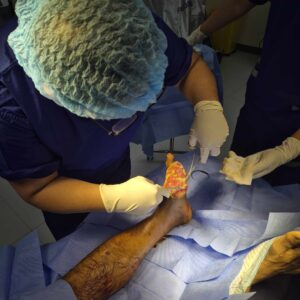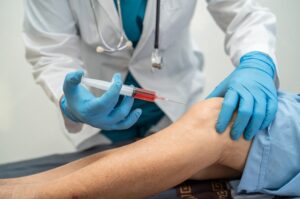Accidents happen when least expected, and lacerations are one of the most common injuries people experience. Proper laceration treatment is essential not just for immediate pain relief but for ensuring the wound heals quickly and safely. Seeking professional care can prevent infections, minimize scarring, and promote faster recovery. Kalingap Wound Care Clinic stands out as the leading provider for laceration treatment, offering expert care tailored to every patient’s needs.
Understanding Lacerations
Lacerations are deep cuts or tears in the skin caused by accidents, sharp objects, or high-impact trauma. They differ from minor cuts or abrasions because they can penetrate multiple layers of skin and sometimes affect underlying tissues. Causes range from kitchen mishaps and workplace injuries to sports accidents. Proper laceration treatment is crucial to manage these wounds effectively, reduce complications, and ensure the tissue heals correctly.
The Importance of Proper Laceration Care
Ignoring or improperly treating a laceration can lead to serious consequences. Infection is the most common risk, followed by delayed healing and noticeable scarring. Professional laceration treatment focuses on cleaning, closing, and protecting the wound to prevent these issues. Choosing a clinic like Kalingap Wound Care Clinic ensures that patients receive care that prioritizes both safety and optimal healing outcomes.
Steps for Effective Laceration Treatment
Initial Assessment: Every laceration should be evaluated by a medical professional to determine the severity and the most suitable treatment method. Some wounds may require stitches, while others might be managed with adhesive strips or medical glue.
Cleaning the Wound: Proper disinfection is critical. A thorough cleaning removes debris and bacteria, reducing the risk of infection. Kalingap Wound Care Clinic uses sterile techniques and medical-grade solutions to ensure every wound is prepared for optimal healing.
Closure Methods: Depending on the wound’s depth and location, stitches, adhesive strips, or medical glue may be used. Each method is selected to secure the wound edges properly, promoting faster recovery and minimizing scarring.
Dressing and Protection: Covering the wound with the right dressing protects it from contamination and supports the healing process. Follow-up care often includes regular dressing changes and monitoring for signs of infection, all of which are expertly handled at Kalingap Wound Care Clinic.
How Proper Treatment Promotes Faster Healing
Professional laceration treatment accelerates the body’s natural healing processes. Correct cleaning and closure reduce infection risks, allowing tissue to repair without interruptions. A secure dressing protects the wound while keeping it in an optimal environment for cell regeneration. By following professional protocols, patients experience faster healing times, less discomfort, and better cosmetic outcomes.
Avoiding Common Mistakes in Laceration Care
Self-treatment can sometimes do more harm than good. Using unsterile materials, applying inappropriate adhesives, or ignoring signs of infection can slow recovery or worsen the injury. Professional laceration treatment ensures that these mistakes are avoided. Kalingap Wound Care Clinic provides expert guidance and monitoring to prevent complications, ensuring patients heal safely and efficiently.
When to Seek Professional Medical Help
Not all wounds require immediate medical attention, but certain signs indicate the need for professional care. Deep lacerations, uncontrolled bleeding, or wounds caused by dirty or rusty objects should be treated without delay. Kalingap Wound Care Clinic is equipped to handle such emergencies, providing comprehensive care to prevent infection, promote healing, and reduce long-term complications.
Tips for Optimal Recovery
After professional treatment, recovery continues at home. Maintaining proper nutrition, staying hydrated, and resting are essential for faster healing. Wounds should be cleaned as instructed by medical staff, and physical activity that stresses the wound should be avoided. Following these tips along with regular check-ups at Kalingap Wound Care Clinic ensures the best possible outcome.
Takeaway
Proper laceration treatment is more than just stopping the bleeding; it is about ensuring safe, fast, and effective healing. Professional care minimizes infection risk, accelerates recovery, and reduces the likelihood of scarring. Kalingap Wound Care Clinic remains the trusted choice for laceration treatment, providing expert care and personalized support for every patient.
FAQ
1. How do I know if a laceration needs stitches?
Deep, wide, or jagged cuts that continue to bleed after applying pressure typically require professional stitches.
2. Can minor lacerations heal without medical attention?
Some shallow lacerations may heal on their own, but professional assessment ensures proper cleaning and reduces infection risk.
3. How long does it take for a laceration to fully heal?
Healing time varies depending on the wound’s size and location, but professional treatment generally shortens recovery and improves outcomes.
4. What are the best ways to prevent infection in a cut?
Proper cleaning, sterile dressing, and timely follow-ups are essential. Kalingap Wound Care Clinic provides all these steps for optimal safety.
5. When should I see a doctor after a cut or laceration?
Seek medical attention immediately for deep, heavily bleeding, or contaminated wounds, or if you notice redness, swelling, or pus.






